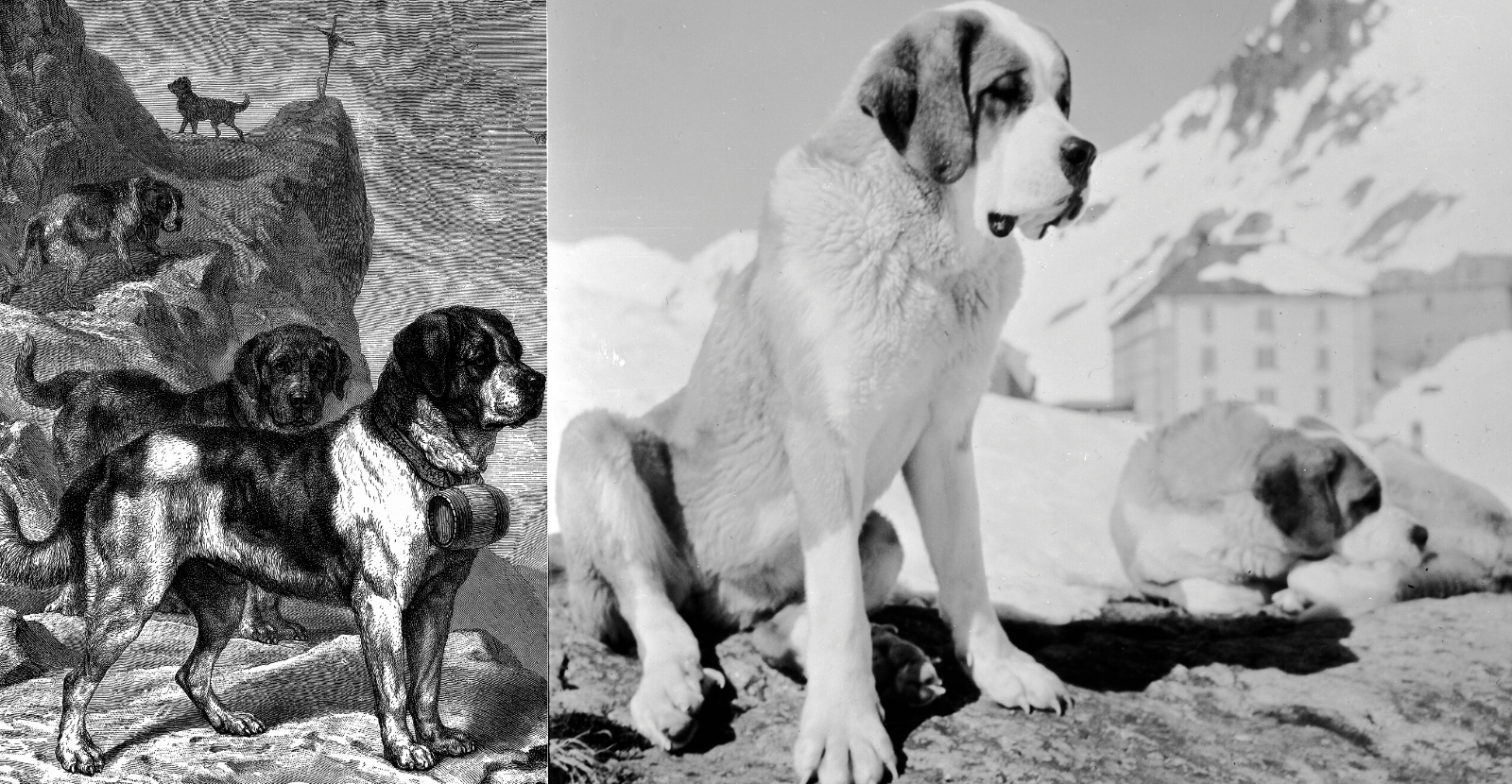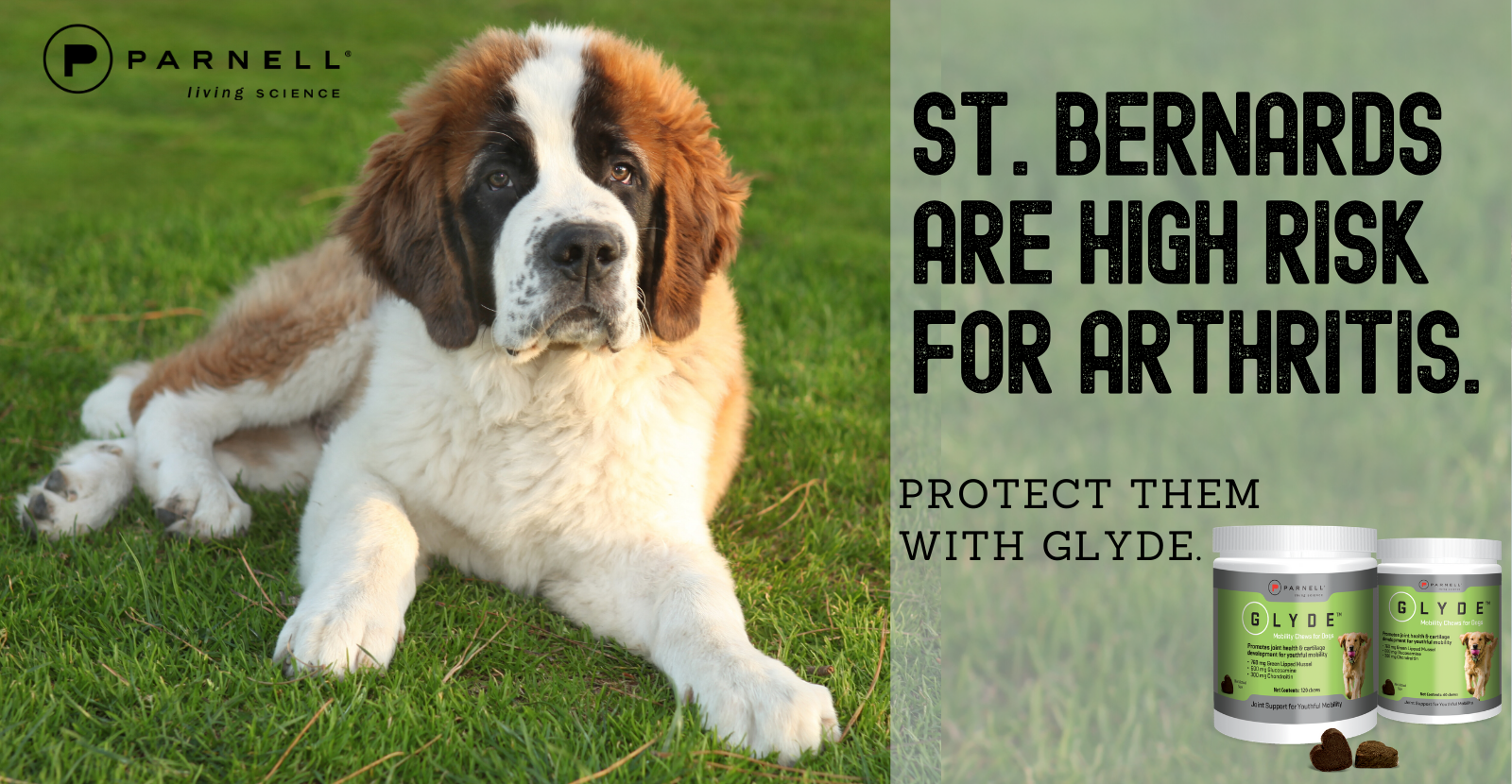Every month, we will highlight a popular dog breed at risk for arthritis. We will talk about what we love about them, as well as reflect on how to keep them healthy. This month, we are focusing on the Saint Bernard, one of the largest breeds of dogs.
Saint Bernards are still known from their intriguing past from their duties as a rescue dog and as the fictional nursemaid “Nana” in Peter Pan. While the last known recorded rescue on ski slopes was documented in 1955, they still enjoy this history and are thought of as the dog breed willing to make serious sacrifices to help their humans.
Today, Saint Bernard dogs are still gentle giants, but more of a family dog than a working dog in most cases. Saint Bernards are still one of the best breeds of dogs out there. Because of their size, there is more to taking care of a Bernie than an average-sized dog. Read on for fun facts about Saint Bernards, their unique history and how to keep them healthy as they age.
Saint Bernard or St. Bernard, both are correct. Some just call them Bernies. No matter what you call them, there are so many reasons to love them. We tried to narrow it down to just 5.
Saint Bernard PUPPIES!

All puppies are cute, but check out the St. Bernard puppy. They are so adorable. They get to their full size by age 2.
Saint Bernard History

St. Bernards have the most interesting history for a dog breed. Originating from Roman Molossian dogs, the St. Bernard is known for centuries of saving lives. They are attributed for saving about 2,000 people over the span of 200 years ranging from lost children to Napoleon’s soldiers to weary travelers succumbing to the frigid temperatures in the Swiss Alps. The original working dog, the breed would use its powerful sense of smell to detect the people buried in the snow. Another benefit to their tracking and locating lost travelers is once they were found, it was easy to warm them up because of their size.
The idea of Bernies wearing barrels of brandy came about from a 19th century painting housed in the National Gallery of Art that illustrated a rescue by the dog. This vision of the St. Bernard became iconic.
Hollywood Loves Saint Bernards
Nana on Peter Pan is still one of our favorite canine movie dogs. Nana is either a Saint Bernard or a Newfoundland, depending on the school of thought. Both are similar in they are very large breed dogs.
Fast-forward a few years and you’ll see the popular dog movies featuring Beethoven, a St. Bernard. Did you know Beethoven the Saint Bernard is one of a few dogs that made it to balloon parade status? He appeared to promote his second movie in 1993 and returned in 1994 and 1995. Then, when Hollywood released another Beethoven's Big Break in 2008, he was back in the lineup. Check out this video of Beethoven in the parade:
St. Bernards are Beautiful

Soft and lovable, the beautiful Bernies have a thick, soft coat. They are simply one of the most beautiful tri-color dogs there are.
St. Bernard Temperament, Big Style

Saint Bernards are known for being good with families and children. Bernies were bred to work and it has now part of their unique style. Because of this instinct to work, they love having an active lifestyle that includes activities with their pet parent such as hiking in the mountains, participating in agility contests, pulling small carts, or working as a service dog. No matter the task, a St. Bernard is smart and hard-working at heart.
Breed Standards
- AKC Breed Popularity: Ranks 48 of 195
- Height: 28-30 inches (male), 26-28 inches (female)
- Weight: 140-180 pounds (male), 120-140 pounds (female)
- Life Expectancy: 8-10 years
- Group: Working Group
Top Health Problems of Saint Bernards
![]()
Some say the bigger the dog, the bigger the love. But others say the bigger the dog, the larger the health problems. With St. Bernards, you can understand that as they age, their health issues will increase because of their size.
The unfortunate fact that really no dog lives nearly long enough, the Bernie’s lifespan is even shorter than an average sized dog. They are expected to only live 8-10 years. Their short life span can be attributed to their tremendous size and heavy weight. It is very important to be sure that you keep your Bernie as healthy as possible with key preventative measures. But first, here are the key health problems to know about when it comes to your Bernie:
Canine Hip & Elbow Dysplasia. Obviously, the larger the St. Bernard, the more issues they will have with their joints. It is important to keep regularly monitoring their mobility and be on the look out for changes in the way they do common activities and willingness to move.
Osteoarthritis, or arthritis in dogs. Because of the joint problems already mentioned, Bernies are at very high risk for osteoarthritis. It is important to make regular assessments of your dog’s mobility.
Take the Arthritis Quiz every 6 months to help prompt you what you should be looking for. It is always a good idea to use joint supplements for Bernies as a preventative measure to keep their joints in good health for as long as possible.
Arthritis is as painful for dogs as it is for humans. And just like humans, there is something you can do about it. Learn more about arthritis in dogs and check out all the risk factors.
Protection and Prevention Key to St. Bernard’s Health
The good news is St. Bernards are typically active and healthy most of their lives. As most of the Bernie’s health problems are joint-related, plan to do what you can to protect and strengthen their joints safely and naturally by adding a joint supplement to their diet. Most dogs need joint supplements by age 8. But since the Bernie’s life expectancy is much shorter, they should begin taking joint supplements even earlier. Joint supplements can promote joint health and cartilage development which keep dogs active and youthful, longer.
Glyde Mobility Chews
Parnell Living Science are the experts on arthritis in dogs. As the creators of Glyde™ Mobility Chews, we developed a unique formula with proven levels of anti-inflammatory ingredients to combat the signs of aging. Glyde uses natural, gluten-free ingredients to promote healthy joints to let your dog do everything he or she loves. Glyde is the only supplement that contains proven levels of three key components that work to relieve the painful signs of arthritis.
Glyde's proven formula has all-natural ingredients and high levels of glucosamine and chondroitin, plus Green Lipped Mussel (GLM). The proven levels of these key ingredients are what makes the formula unique:
- New Zealand Green Lipped Mussel (GLM):A powerful anti-inflammatory
- Glucosamine: Reduces cartilage degradation
- Chondroitin Sulfate: Helps rebuild cartilage
Using Glyde as a preventative measure to protect your St. Bernard's joints is wise to reduce the impact of impending arthritis. If you do not use Glyde, try a joint supplement of some sort. It is important to protect your Bernie's joints as this can lead to further health problems down the road. No matter what, be sure to keep your adorable St. Bernard happy and healthy for their best life with you!



.png)

